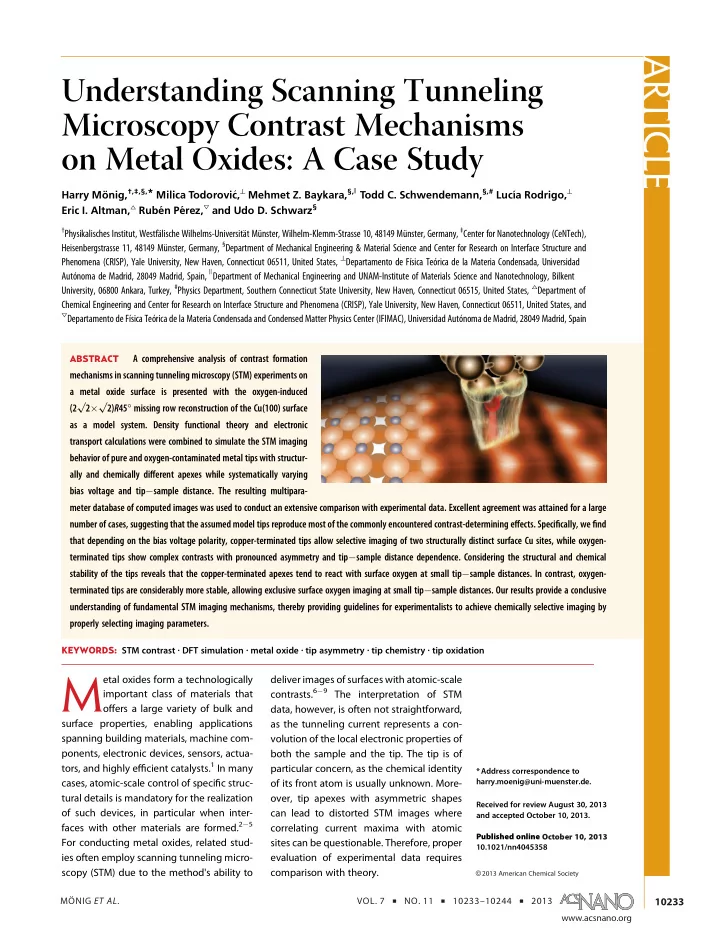

ARTICLE Understanding Scanning Tunneling Microscopy Contrast Mechanisms on Metal Oxides: A Case Study c, ^ Mehmet Z. Baykara, §, Todd C. Schwendemann, §,# Lucı ¨ nig, †,‡,§, * Milica Todorovi � ) ´a Rodrigo, ^ Harry Mo Eric I. Altman, 4 Rube ´rez, 3 and Udo D. Schwarz § ´n Pe † Physikalisches Institut, Westfälische Wilhelms-Universität Münster, Wilhelm-Klemm-Strasse 10, 48149 Münster, Germany, ‡ Center for Nanotechnology (CeNTech), Heisenbergstrasse 11, 48149 Münster, Germany, § Department of Mechanical Engineering & Material Science and Center for Research on Interface Structure and Phenomena (CRISP), Yale University, New Haven, Connecticut 06511, United States, ^ Departamento de Física Teórica de la Materia Condensada, Universidad ) Autónoma de Madrid, 28049 Madrid, Spain, Department of Mechanical Engineering and UNAM-Institute of Materials Science and Nanotechnology, Bilkent University, 06800 Ankara, Turkey, # Physics Department, Southern Connecticut State University, New Haven, Connecticut 06515, United States, 4 Department of Chemical Engineering and Center for Research on Interface Structure and Phenomena (CRISP), Yale University, New Haven, Connecticut 06511, United States, and 3 Departamento de Física Teórica de la Materia Condensada and Condensed Matter Physics Center (IFIMAC), Universidad Autónoma de Madrid, 28049 Madrid, Spain A comprehensive analysis of contrast formation ABSTRACT mechanisms in scanning tunneling microscopy (STM) experiments on a metal oxide surface is presented with the oxygen-induced √ √ (2 2 � 2) R 45 � missing row reconstruction of the Cu(100) surface as a model system. Density functional theory and electronic transport calculations were combined to simulate the STM imaging behavior of pure and oxygen-contaminated metal tips with structur- ally and chemically di ff erent apexes while systematically varying bias voltage and tip � sample distance. The resulting multipara- meter database of computed images was used to conduct an extensive comparison with experimental data. Excellent agreement was attained for a large number of cases, suggesting that the assumed model tips reproduce most of the commonly encountered contrast-determining e ff ects. Speci fi cally, we fi nd that depending on the bias voltage polarity, copper-terminated tips allow selective imaging of two structurally distinct surface Cu sites, while oxygen- terminated tips show complex contrasts with pronounced asymmetry and tip � sample distance dependence. Considering the structural and chemical stability of the tips reveals that the copper-terminated apexes tend to react with surface oxygen at small tip � sample distances. In contrast, oxygen- terminated tips are considerably more stable, allowing exclusive surface oxygen imaging at small tip � sample distances. Our results provide a conclusive understanding of fundamental STM imaging mechanisms, thereby providing guidelines for experimentalists to achieve chemically selective imaging by properly selecting imaging parameters. KEYWORDS: STM contrast . DFT simulation . metal oxide . tip asymmetry . tip chemistry . tip oxidation etal oxides form a technologically deliver images of surfaces with atomic-scale M contrasts. 6 � 9 The interpretation of STM important class of materials that o ff ers a large variety of bulk and data, however, is often not straightforward, surface properties, enabling applications as the tunneling current represents a con- spanning building materials, machine com- volution of the local electronic properties of ponents, electronic devices, sensors, actua- both the sample and the tip. The tip is of tors, and highly e ffi cient catalysts. 1 In many particular concern, as the chemical identity * Address correspondence to harry.moenig@uni-muenster.de. cases, atomic-scale control of speci fi c struc- of its front atom is usually unknown. More- tural details is mandatory for the realization over, tip apexes with asymmetric shapes Received for review August 30, 2013 of such devices, in particular when inter- can lead to distorted STM images where and accepted October 10, 2013. faces with other materials are formed. 2 � 5 correlating current maxima with atomic Published online October 10, 2013 For conducting metal oxides, related stud- sites can be questionable. Therefore, proper 10.1021/nn4045358 ies often employ scanning tunneling micro- evaluation of experimental data requires scopy (STM) due to the method's ability to comparison with theory. C 2013 American Chemical Society ’ NO. 11 ’ 10233 – 10244 ’ 2013 MÖNIG ET AL . VOL. 7 10233 www.acsnano.org
Recommend
More recommend